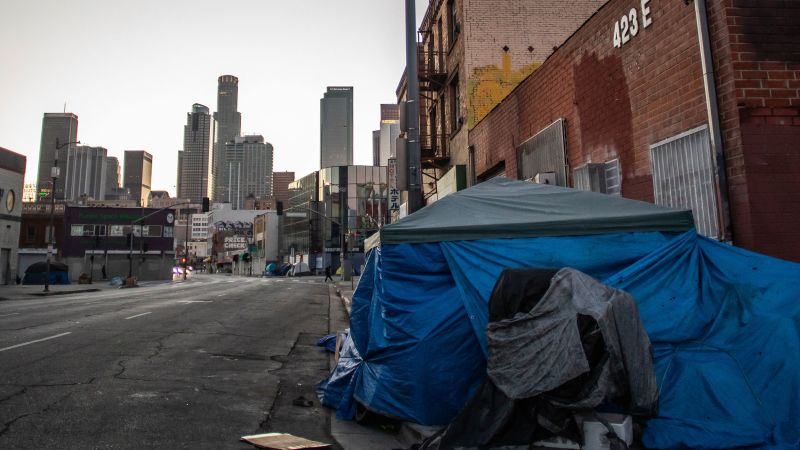Trump wants to force mentally ill homeless people into hospitals and treatment. He’s cutting the programs that fund them

Last month, a homeless man with a history of serious mental illness killed a woman on a Charlotte train. The murder, shown on video, spurred calls from some for a tougher approach to dealing with the rise of homelessness and mental health issues across the United States.
A record number of Americans are living on the streets, roughly a quarter with schizophrenia, bipolar disorder or other severe mental illness. The overwhelming majority pose no public danger, and research links only 3% to 5% of violent acts to those with serious mental illness.
President Donald Trump, however, frames homeless people with mental illness as a public safety threat. The solution, he says, is to commit more people into psychiatric hospitals and treatment programs against their will.
Trump released an executive order in July encouraging states to expand involuntary commitment laws — a legal process forcing people considered a danger to themselves or others into inpatient psychiatric care.
“Shifting homeless individuals into long-term institutional settings…will restore public order,” Trump’s order said. He also said in August that he would support the government reopening “insane asylums” for people with serious mental illness.
But psychiatric hospital beds, treatment slots and mental health care workers have been in short supply for years. And Trump’s cuts this year to Medicaid, housing assistance and mental health programs will make it harder to add psychiatric beds, undermining his goal of increasing involuntary commitment.
“The big problem is that the mental health care system we have is grossly inadequate. It’s underfunded and overburdened,” said Jeffrey Swanson, a professor in psychiatry and behavioral sciences at Duke University.
In 2022, the United States had just 18 psychiatric beds per 100,000 people, according to the Substance Abuse and Mental Health Services Administration (SAMHSA) — this was far below the roughly 60 beds experts estimate are necessary so anyone who needs a bed can get one. About 20% of the 14 million adults with serious mental illness do not receive treatment.
Trump’s order isn’t just about hospitalizing people. He also wants states to expand assisted outpatient treatment (AOT) — a court-ordered program for people who are deemed unable to live safely without supervision by a judge. AOT programs offer therapy, medication and other intensive services for people outside a hospital setting.
Expanding AOT alone is not a silver bullet, Swanson said. AOT’s effectiveness depends on pairing treatment with affordable housing, services and other support, he said.
Yet the Trump administration has not pledged any new federal money for AOT programs, psychiatric hospital beds or other treatment.
“The administration wants to force people into treatment that may not exist. It’s a bridge to nowhere,” Swanson said.
The White House did not provide comment to CNN’s questions for this article.
Steep cuts to the safety net
Forced hospitalization can be a critical tool when someone is dangerous, either to themselves or others, and is unwilling to engage in treatment, say many legal, advocacy and medical professionals.
But advocates for people with mental illness say involuntary commitment risks further traumatizing people and costs more. Research shows that engaging people voluntarily with treatment and services for their mental health care is less expensive and produces better long-term outcomes.
However, the political climate has shifted in recent years as homelessness has soared, driven by a lack of affordable housing. More than 770,000 people in the United States experienced homelessness in 2024, an 18% increase from 2023, the latest data showed. New York, California, Oregon and other Democratic-led states and cities have supported expanding involuntary commitment.
Under New York Gov. Kathy Hochul, for example, the state has added hospital beds to state psychiatric centers and loosened the state’s legal standard for involuntarily commitment.
But even those who support increasing involuntary commitment acknowledge that several of Trump’s recent policies work in opposition to his goals of expanding hospitalization and treatment.
“There are cuts that have been made that won’t help with this strategy and are inconsistent with how to make it work,” said Lisa Dailey, the executive director of the nonprofit Treatment Advocacy Center, which lobbies for broader involuntary commitment standards. “The cuts to Medicaid are going to be devastating.”
Trump’s broad spending and tax bill is projected to slash Medicaid — the most important source of public mental health care services — by more than $900 billion over the next decade. According to nonprofit KFF, more than one in three adult Medicaid enrollees has a mental illness, including 10% with a serious mental illness — higher than rates among adults with private or no insurance.
The Trump administration has also cut a slew of programs for mental health treatment and substance abuse, including $1 billion from SAMHSA. It’s also trying to shift funding from Housing First, a policy that moves chronically homeless people into long-term housing without preconditions and then pairs them with support services.
“What you see is cutting off resources for community-based services,” said Luke Sikinyi, the director of public policy and public engagement for the Alliance for Rights and Recovery in New York. “We’re creating a situation where more people experience homelessness and it’s more difficult for providers.”
Hope of deinstitutionalization
Trump’s push represents a major policy shift. Since the 1950s, America has worked to close psychiatric institutions.
In 1955, there were more than 550,000 state and county psychiatric beds. Today, there are an estimated 36,000 psychiatric beds at state hospitals.
Deinstitutionalization was driven by many forces, including survivors’ accounts of electric shock therapy and other abuses in state mental hospitals. It was also spurred by the introduction of the antipsychotic drug chlorpromazine in the 1950s; the 1963 Community Mental Health Act to fund a system of local mental health care centers; changes in Medicaid; and landmark court decisions and federal civil rights laws.
But despite the move toward deinstitutionalization, a comprehensive mental health care system that supported people living outside hospitals never fully materialized.
Fewer than half of the community mental health centers proposed by the 1963 Community Mental Health Act were ever built. In 1981, President Ronald Reagan cut federal funding for mental health programs by 25%.
Street homelessness grew in cities in the late 1970s, and budget-strapped states shifted the burden of mental health care to federal programs like Medicaid.
Today, people in the grips of psychosis are sometimes “boarded” in emergency departments and released back on to the street in days.
But more often, people with serious mental illness wind up in prisons and jails, which have become the nation’s largest mental health care facilities.
Beds aren’t enough
The federal government today has limited control over mental health issues. Civil commitment laws are governed by states, and courts have established constitutional protections over decades.
But Trump has the bully pulpit, and his executive order is a way to encourage local and state policy changes, said Stephen Eide, who studies homelessness at the conservative think tank Manhattan Institute.
“I want to see untreated serious mental illness prioritized, period. This executive order is an effective way to do it,” he said.
Eide and other proponents of expanding hospitalization believe the administration could do even more. He advocates repealing Medicaid’s “institutions for mental disease” (IMD) exclusion. This obscure rule bars federal funding for mental institutions with more than 16 beds, which critics say is a major barrier to expanding capacity.
The administration has approved dozens of state waivers allowing Medicaid to pay for mental health services for people in institutions, but it has not backed efforts to repeal the IMD exclusion. Eliminating it could increase Medicaid spending by $38 billion, running counter to Trump’s goals.
But Dominic Sisti, a University of Pennsylvania professor of medical ethics who co-wrote a 2015 paper arguing for high-quality psychiatric hospitals, said only adding beds is a misplaced strategy.
What’s desperately needed, Sisti said, are comprehensive investments in mental health — Housing First programs, funding to build up a mental health care workforce, and an easily accessible and coordinated system of voluntary treatment that prevents people from deteriorating on the streets.
“It’s very difficult for people to access adequate mental health care,” he said. “Our system has broken down so completely because we refuse to invest in the care of people who are most vulnerable.”



